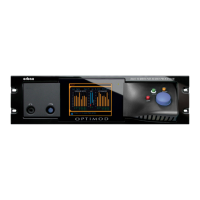OPTIMOD SURROUND PROCESSOR INSTALLATION
2-29
See step 8 on page 2-11 for more about these choices.
H) Set the 2.0
OUTPUT PREEMPHASIS control. The choices are FLAT, 50μs or 75μs.
• Use F
LAT if you are driving a channel that does not use preemphasis. (Very
few digital channels use preemphasis.) Set the control F
LAT for DAB, DRM,
HD Radio, digital television, netcasts, and any other channel that uses a
lossy codec. When in doubt, set this control F
LAT.
• Use 50μs if you are driving a channel that is preemphasized at 50μs, such as
an analog TV aural transmitter in European countries.
• Use 75μs if you are driving a channel that is preemphasized at 75μs, such as
an analog aural transmitter in the Americas (Region 2).
When the control is set to 50μs or 75μs, the signal feeding the 2.0 look-
ahead limiter has this preemphasis applied to it before it feeds the limiter
and complementary deemphasis is applied after the limiter. The fre-
quency response through the limiter therefore remains flat below the
threshold of limiting but high frequencies cause the limiter to produce
more wideband gain reduction than do low frequencies. Because deem-
phasis is applied after the limiter, the transmitter that follows the 8685’s
output must apply the final transmission preemphasis.
With 5-Band presets, the O
UTPUT PREEMPHASIS control determines if the 5-
band compressor’s sidechain is preemphasized at
50μs or 75μs. This makes
the 5-band compressor “preemphasis-aware,” allowing bands 4 and 5 to
be used as a high-frequency limiter to prevent the look-ahead limiter
(which creates wideband gain reduction) from creating audible “pump-
ing” or “gulping” artifacts on program material that is rich in high fre-
quencies, like “esses” in speech.
The 2.0 processing in the “TVA” presets is tuned to complement 50μs and
75μs preemphasis. See Table 3-1 on page 3-27.
I) Set the 2.0
OUTPUT DELAY control.
This sets the time delay between the 8685’s input and output in units of
milliseconds or frames. All common frame rates are supported without
the need to convert them into milliseconds.
M
INIMUM delays the signal as little as possible. When MINIMUM is chosen,
the delay will depend on which output feed is in use (step (G) above) and
the
setting of the active preset’s AGC
CROSSOVER control. However, if the
delay is not set to M
INIMUM, the delay through the 8685 will be the same
as the setting of the 2.0
OUTPUT DELAY control regardless of the settings
of other controls.
In most cases, it is appropriate to set the delay so that is equal to one or
two frames of the television standard that you are using. (Two frames are
required for 59.94/60 fps progressively scanned video.) This allows you to
apply video delay to maintain AV sync accurately.
If you are using an HD-SDI connection with the 8685’s optional HD-SDI
module, the 8685 can apply the appropriate video delay.

